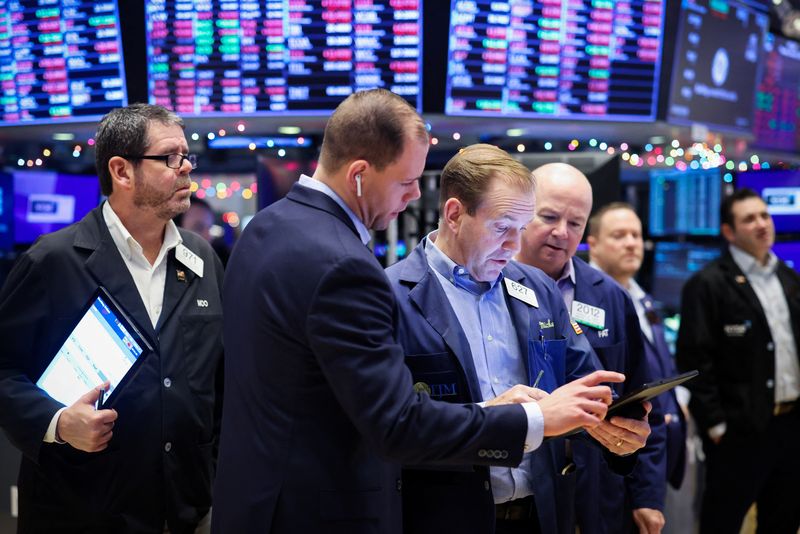
© Reuters. Traders work on the trading floor at the New York Stock Exchange (NYSE) in New York City, U.S., January 5, 2023. REUTERS/Andrew Kelly
By Chuck Mikolajczak
NEW YORK (Reuters) – The Dow stumbled more than 1% on Tuesday as weak earnings from Goldman Sachs dragged the index lower, but a jump in Tesla (NASDAQ:) shares helped keep the benchmark and Nasdaq near the unchanged mark.
Goldman Sachs Group Inc (NYSE:) slumped 6.91% and was poised for its biggest one-day percentage drop since June 2020 after the bank reported a bigger-than-expected drop in quarterly profit. The decline in Goldman shares, the second-most expensive of the Dow Industrials, pulled the price-weighted index lower as the biggest drag.
For a price-weighted index such as the Dow, the share value of a stock is proportional to its contribution in the index, in contrast to the market capitalization-weighted S&P 500.
Also weighing on the blue-chip Dow index was insurer Travelers (NYSE:) Cos Inc, which slumped 4.8% after forecasting fourth-quarter earnings below estimates.
But a 6.52% jump in Tesla Inc helped keep the S&P 500 and Nasdaq afloat. The electric-vehicle maker’s January retail sales surged in China following recent price cuts on its top-selling models, data from China Merchants Bank International showed.
The fell 353.76 points, or 1.03%, to 33,948.85, the S&P 500 lost 6.98 points, or 0.17%, to 3,992.11 and the added 6.28 points, or 0.06%, to 11,085.44.
Morgan Stanley (NYSE:) climbed 6.86% as it beat analysts’ estimates for fourth-quarter profit as its trading business got a boost from market volatility.
Earnings from Goldman Sachs and Morgan Stanley close out what was a mixed bag for big banks, many of which have stashed rainy-day funds to gird against a potential recession.
Analysts expect year-over-year earnings from S&P 500 companies to decline 2.4% for the quarter, according to Refinitiv data, compared with a 1.6% decline at the start of the year.
Data showed New York state manufacturing contracted sharply in January as orders collapsed and employment growth stalled, pointing to continued weakness in national factory activity, fueling recession concerns.
Equity markets have gotten off to a strong start this year after a dismal performance in 2022, on hopes that easing inflation and a slowdown in the economy, especially the labor market, would give the Federal Reserve the leeway to scale back the size of interest rate hikes it has used to combat high prices.
The Dow was on track to snap a four-session win streak, while the Nasdaq was on pace for its seventh straight gain, its longest streak since November 2021.
Money market participants are currently expecting a 25-basis point interest rate hike from the U.S. central bank in February and see rates peaking at 4.9% in June, while the Fed’s projections are for over 5%.
U.S.-listed shares of Chinese companies declined, with JD (NASDAQ:).Com Inc down 6.01% and Baidu Inc (NASDAQ:) off 6.45% after China’s economic growth in 2022 slumped to one of its worst levels in nearly half a century.
Advancing issues outnumbered declining ones on the NYSE by a 1.09-to-1 ratio; on Nasdaq, a 1.00-to-1 ratio favored advancers.
The S&P 500 posted 13 new 52-week highs and one new low; the Nasdaq Composite recorded 85 new highs and nine new lows.





